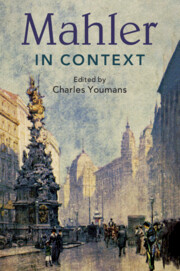Book contents
- Mahler in Context
- Composers in Context
- Mahler in Context
- Copyright page
- Dedication
- Contents
- Figures
- Music Examples
- Notes on Contributors
- Preface and Acknowledgments
- Abbreviations
- Part I Formation
- Part II Performance
- Part III Creation
- Part IV Mind, Body, Spirit
- Part V Influence
- Chapter 27 Posthumous Reputation, 1911 to World War II
- Chapter 28 Mahler and the Second Viennese School
- Chapter 29 The Mahler Revival
- Chapter 30 Broader Musical Influence
- Chapter 31 Adorno
- Chapter 32 Influences in Literature
- Chapter 33 Mahler on Disc
- Chapter 34 Film and Recent Popular Culture
- Further Reading
- Index
Chapter 29 - The Mahler Revival
from Part V - Influence
Published online by Cambridge University Press: 18 December 2020
- Mahler in Context
- Composers in Context
- Mahler in Context
- Copyright page
- Dedication
- Contents
- Figures
- Music Examples
- Notes on Contributors
- Preface and Acknowledgments
- Abbreviations
- Part I Formation
- Part II Performance
- Part III Creation
- Part IV Mind, Body, Spirit
- Part V Influence
- Chapter 27 Posthumous Reputation, 1911 to World War II
- Chapter 28 Mahler and the Second Viennese School
- Chapter 29 The Mahler Revival
- Chapter 30 Broader Musical Influence
- Chapter 31 Adorno
- Chapter 32 Influences in Literature
- Chapter 33 Mahler on Disc
- Chapter 34 Film and Recent Popular Culture
- Further Reading
- Index
Summary
The Mahler Revival of the early 1960s, a movement galvanized by the centenary of the composer’s birth, bears scrutiny for the diverse ways in which the renewed interest shaped the reception of his music. The term “revival” perhaps overstates the case, as Mahler’s name was by no means unknown in the first half of the 1900s: performances of his music occurred, albeit infrequently; most works had been recorded; editions had been published and were still available; and the composer had been the subject of several biographies. The new elements, surveyed here, include an unprecedented intensity of activity in three specific areas: recordings, particularly full cycles, first by Bernstein but soon followed by Solti, Karajan, Haitink, Inbal, Chailly, and others; lectures and published research, here again spearheaded by a clear leader, Adorno, but with a substantial body of secondary (and far less notorious) figures; and new editions, most importantly, the Gesamtausgabe begun in 1959.
Keywords
- Type
- Chapter
- Information
- Mahler in Context , pp. 251 - 257Publisher: Cambridge University PressPrint publication year: 2020

